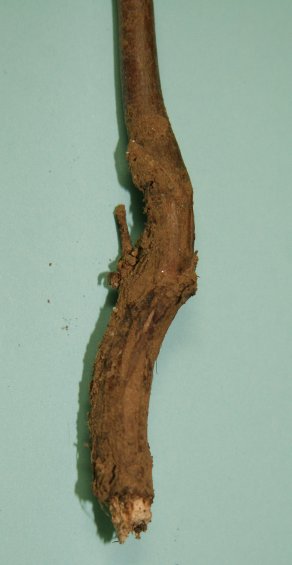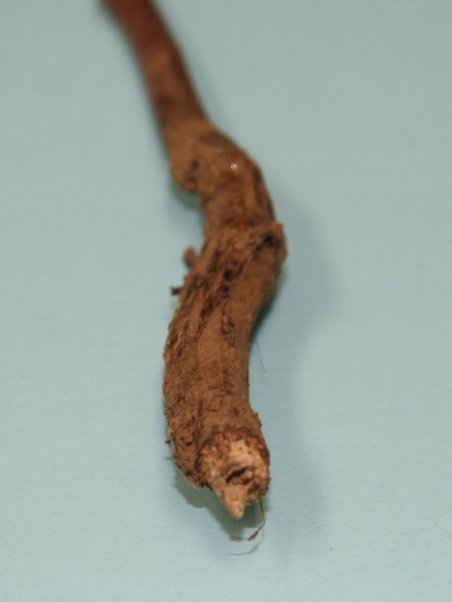| |
Ever wonder why deer like to munch on chestnut trees? Simply, chestnut tree
branches and roots taste sweet to many creatures that wander into the
chestnut orchard.
When chestnut trees are young and small they are very susceptible to damage and
destruction from deer and rodents.
See pictures to the left of a chestnut seedling munched to death at the point
where the tree met the ground.
There are only two ways to keep from
getting damage from deer. The easiest is to only plant chestnut trees where
deer are nowhere to be found. The other method is to install an 8 to 10 foot
high fence around the orchard. The fence can be either electric or wire mesh.
If you install an electric fence you will need to setup 4 electric wires.
Starting from the ground the first wire will be at 12 inches. The second wire
will be at 30 inches. The third wire will be at about 60 inches (5 feet). And
the top wire will be just below the top at 96 inches (8 feet). If deer are
passing through your orchard then you must provide them a path around the
orchard. If there is no way around the orchard then they will continue to
enter no matter what fence you put in. If addition to the path problem there
is a food problem. If the only food available is in the orchard then there is
almost no way to stop them other than destroying the deer. Even if you do that
other deer will come in and take their place.
Rodents such as voles, field mice, rabbits, and maybe rats too will chew on
the sweet chestnut tree bark, just like they do on fruit trees. A simple and
effective method of controlling damage to trees from these critters is to
paint the base of the tree up to the maximum depth of any snow you may get
(rabbits eat even when the snow is deep) plus 12 inches with interior latex
paint spiked with course sand. Ever eat a hot dog cooked over a outdoor fire
that had sand in it. Was not so nice to chew on, was it? Same goes for these
rodents. They do not like sand in their mouths either.
Voles also present problems with eating the roots of the trees near the soil
surface. If your orchard has a vole problem where they are destroying your
chestnut trees, you may have to take additional actions. The first is some-
thing you should already be doing, that is keeping the ground bare around
the trees for a minimum distance of 36 inches (1 meter). Aside from this the
last option is to bait. Check with local nurseries or other orchards to
see what they are doing to control the voles.
Remember, a clean well kept orchard is not the place where rodents take up
residence. They like areas where there is cover near by to protect them if
some predator comes along. Remove things such as orchard waste (leaves,
branches, dead wood, or lumber/wood), brush, and grass clippings. Don't let
the grass grow higher than 4-5 inches before it is cut back again. Short
grass is one of the most important controls since the rodents have nowhere
to hide. One last thing, be a good host for rodent predators - hawks, snakes,
foxes, coyotes, cats and whatever else rodents in your area.
Over the past 3 years mole chasers have been installed in the seedling beds to
help control voles eating on the seedling roots. The cost of the chasers was
about $15.00/each.
Using physical barriers is the most effective control for goffers, voles,
mice, and rabbits. The best readily available material is thin smooth walled 4
inch PVC pipe used for waste water/sewer. Cut the pipe into 2 foot lengths.
When the chestnut tree is planted, insert the pipe 12 inches into the ground
with the tree inside the pipe. Leave 12 inches of pipe above the ground. When
the tree grows to about 2 inches in diameter or 10 feet tall, the pipe must be
removed. Remove the pipe by pulling it out of the ground and making a cut down
the length of the pipe. This will allow the pipe to be removed from round the
tree.
|
|
|
|

This chestnut tree was chewed off at the ground by a rodent. The damage was
found in early January. The seedling was leaning over at an unusual angle.
A small tug on the tree caused the tree to come out of the ground.

Same seedling as above from a different angle. There is no chance this seedling
will survive once it was chewed up by a rodent (likely a vole).
Contact Information:
Farm Location:
6160 Everson Goshen Rd
Everson, WA 98247
Ph: (360) 592-3397
Business Offices:
Washington Chestnut Company
6160 Everson Goshen Rd.
Everson, WA 98247
Ph: (360) 592-3397
|
|


